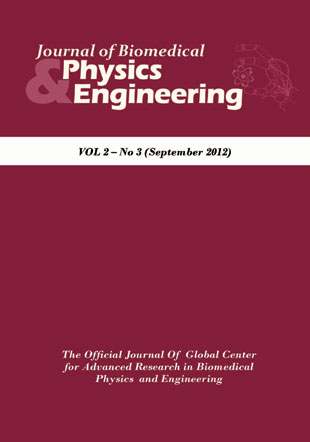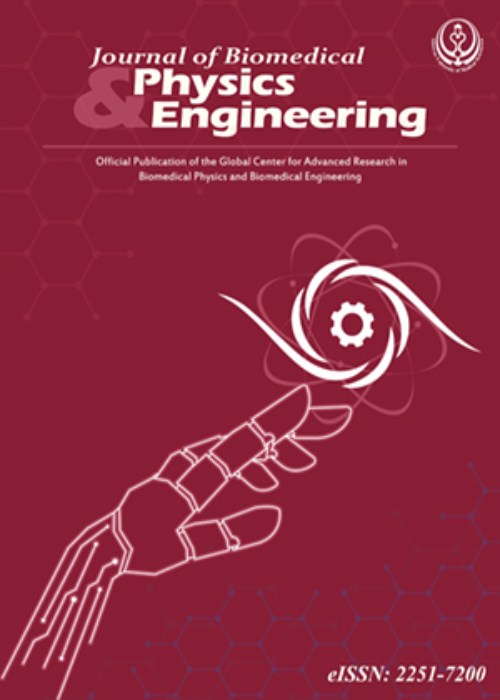فهرست مطالب

Journal of Biomedical Physics & Engineering
Volume:2 Issue: 3, May-Jun 2012
- تاریخ انتشار: 1391/07/11
- تعداد عناوین: 6
-
-
Page 83BackgroundSeveral multiphase flow analyses have been developed to predict the fate of particles used in inhalation drug delivery; however, the collapse of drop lets during their passage through respiratory tract has not been investigated.ObjectiveTo assess the probability of droplet collapse in the upper respiratory tract.MethodsA 3D model of mouth-to-second generation airway after the trachea was developed with application of a computational fluid dynamics modeling. A new parameter, the droplet collapsibility index (DCI), was defined to evaluate the prob ability of droplet collapse during the release of droplets through the model.ResultsThe results stated that droplets with diameter between 0.1 and 1 μm are at higher risk of collapse. Also, the most probable region of collapse was found to be the glottal bend. The condition becomes progressively worse by increasing the rate of breathing air flow. By increasing the inspiration flow rate from 10 to 30 L/min, the droplet collapsibility rised from 0.75 to 2.25—exceeding the collapsibility threshold.ConclusionResults of the current study can be used in evaluation of collapsibil ity of particles in design of inhalation drug delivery systems.Keywords: Drug delivery, Respiratory system, Inhalation, Droplet collapsibility, Computa¬tional fluid dynamics
-
Page 93BackgroundThe interaction between the blood and the vessel wall is of great clinical interest in studying cardiovascular diseases, the major causes of death in developed countries.ObjectiveTo understand the effects of incorporating fluid-structure interaction into the simulation of blood flow through an anatomically realistic model of abdomi¬nal aorta and renal arteries reconstructed from CT images.MethodsThe fluid is assumed to be incompressible and non-Newtonian and the vessel wall is set to have isotropic elastic properties. The blood flow is assumed to be periodic; therefore, a real pulsatile flow velocity in the entrance of the abdomi¬nal aorta of a healthy adult is measured via laser Doppler anemometry and used in this study. The effects of wall flexibility, both rigid and compliant models were also simulated.ResultsComparison of the rigid model with compliant model reveals that veloc¬ity and pressure drop in flexible arteries is less than those in rigid arteries. As wall shear stress plays an important role in the function of the cardiovascular system as it has immediate effect on the endothelial histology, the wall shear stress was analyzed; the rigid model wall shear stress magnitude was higher than that in the compliant model. It was also observed that the peak values of wall shear stress in this study were not high enough to be able to damage and strip the endothelial cells. Displace¬ments of vessel walls were also studied; it was found that the wall displacement dur¬ing the systole was higher than the diastole.ConclusionIncorporating fluid-structure interaction and considering vessel wall deformations in studying blood flow through arteries have notable effects on blood flow characteristics.Keywords: Blood flow, pulsatile, Abdominal aorta, Renal arteries
-
Page 103BackgroundLaser-tissue interaction on low-level laser therapy (LLLT) has widespread medical applications (e.g., improved wound healing). The tensile strength of radiated tissue by LLLT is known to be increased mainly because of cross collagen bands developed after radiation.ObjectiveIn this work, we studied the instantaneous effect of radiation of polar¬ized laser beam on the viscoelastic tissue properties.MethodsThe viscoelastic behavior of tissue was investigated by experimental measurement and analyses of stress-strain plots.ResultLLLT increased the viscoelastic properties of the irradiated soft tissue. The maximum variation in viscoelasticity was attained when the direction of laser polarization is parallel to the tissue stretch vector. The variation also depended on duration of laser irradiation.ConclusionViscoelastic properties of soft tissue can be changed by polarized laser radiation.Keywords: Viscoelastic behavior, He, Ne laser, Polarization, Exposure time, Collagen fiber, Soft tissue, Tensile strength
-
Page 108Periodontal ligament is a thin layer of soft tissue that connects root of a tooth to the surrounding alveolar bone. These ligaments play an important role in initiating tooth movement when loads are applied to teeth with orthodontic appliances. The majority of such soft tissues exhibit as viscoelastic bodies or have a time-dependent behavior. Due to the viscoelastic behavior of the periodontal ligaments, the mechani¬cal properties are strongly affected by the loading history. Poisson’s ratios for the viscoelastic materials are time-dependent (in time domain) or complex frequency-de¬pendent (in frequency domain) quantities. Moreover, three-dimensional stress fields depend on these Poisson’s ratios. The main objective of this work was to develop a mathematical approach capable of determining the time-dependent Poisson’s ratios of the periodontal ligaments based on experimental data of stress relaxation and creep tests. The resulting stress relaxation and creep curves are described by a three-pa¬rameter viscoelastic models. The time-dependent Poisson’s ratios of the periodontal ligaments have been obtained as increasing functions of time, because shear modulus of these ligaments relaxes much more than their bulk modulus.Keywords: Poisson's Ratio, Viscoelastic, Stress, relaxation, Creep, Periodontal ligament
-
Page 116BackgroundThe number of interventional cardiology procedures performed has increased rapidly over the past years. While these procedures help physicians avoid using highly complicated invasive methods, it usually leads to high levels of expo-sure to ionizing radiation of both patients and cardiologist. The dose received by the cardiologist during interventional cardiology procedures is determined by a wide range of factors such as clinical problems to be treated, the interventional technique to be used, the x-ray system employed, experience of the cardiologist, the protective measures taken as well as their use during the examination.ObjectiveTo measure the dose received by 22 cardiologists, radiology resi¬dents, radiologic technologists and nurses during interventional cardiology exami¬nations performed in various teaching hospitals affiliated to Shiraz University of Medical Sciences.MethodsThe radiation dose was basically measured by thermoluminescence dosimeters (TLD). Other personal dosimetry devices such as film badges and pen dosimeters were also used. According to IAEA guidelines, the dosimeter should be worn under the lead apron (at waist level) for estimating the effective dose but due to high workload in interventional radiology and since the areas of the body which are not protected by the apron receive much higher radiation doses, in this study an additional dosimeter was used over the apron (at collar level).ResultsThe mean±SD monthly dose recorded by dosimeters of cardiologists over the apron at collar level was 912.1±224.4 (range: 660.8–1176.4) μGy; hands received doses up to 9674.4 μGy month−1 as recorded by TLD chips.ConclusionThe annual effective dose received by interventional cardiologists who use standard lead aprons hardly reaches the occupational exposure dose limit of 20 mSv/y.Keywords: Interventional cardiology, Radiation, Dose, Cardiologists, Radiation protection


